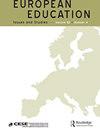学生特征与国际流动障碍:来自欧盟的证据
IF 0.9
Q4 EDUCATION & EDUCATIONAL RESEARCH
引用次数: 0
摘要
我们使用欧洲晴雨表的数据来检查国际学生流动的障碍。本文采用多变量分析的方法研究了个体特征与阻碍高等教育学生在另一个欧盟国家参与活动的障碍之间的关系。结果表明,居住区域、性别和年龄等人口因素与态度、信息和经济障碍有关。这些发现可能有助于确定使国际学生流动更具包容性的措施。本文章由计算机程序翻译,如有差异,请以英文原文为准。
Student Characteristics and Barriers to International Mobility: Evidence from the European Union
We use Eurobarometer data to examine barriers to international student mobility. Multivariate analysis is employed to study how individual characteristics are related to the obstacles preventing higher education students from participating in activities in another EU country. The results suggest that several demographic factors including area of residence, gender and age are associated with attitudinal, informational and financial barriers. These findings may help in the identification of measures to make international student mobility more inclusive.
求助全文
通过发布文献求助,成功后即可免费获取论文全文。
去求助
来源期刊

European Education
EDUCATION & EDUCATIONAL RESEARCH-
CiteScore
1.20
自引率
0.00%
发文量
5
期刊介绍:
uropean Education is published in association with the Comparative Education Society in Europe (CESE). It is an international peer-reviewed journal devoted to original inquiries and dialogue on education across the member states of the Council of Europe. Established in 1969, the journal features articles on education in individual member states, comparative studies on education across Europe, as well as the impact of European education initiatives globally. The journal especially encourages theoretical and empirical studies, interdisciplinary perspectives, and critical examination of the impact of political, economic, and social forces on education. European Education includes reviews of books and educational films, including those published/produced in English and other languages.
 求助内容:
求助内容: 应助结果提醒方式:
应助结果提醒方式:


